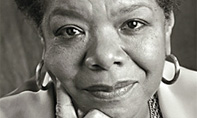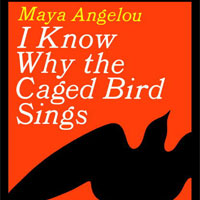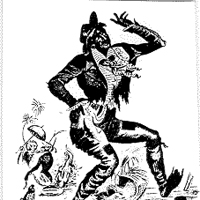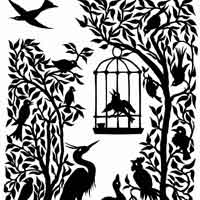- About Us
- Columns
- Letters
- Cartoons
- The Udder Limits
- Archives
- Ezy Reading Archive
- 2024 Cud Archives
- 2023 Cud Archives
- 2022 Cud Archives
- 2021 Cud Archives
- 2020 Cud Archives
- 2015-2019
- 2010-2014
- 2004-2009
 |
The Cud On Literature: Why The Caged Bird Sings For Black America |

Maya Angelou's autobiographical 1969 novel I Know Why The Caged Bird Sings recounts her childhood growing up in Stamps, Arkansas, during the 1930's with her brother Bailey and grandmother, who operated the local general store. Though now familiar to a wide audience –the book is still required reading in many schools- the intimate memoir’s illumination of several of the major themes central to the black experience in America are not only worthy of reminder, but merit our return to consider this modern classic time and time again.
In the first and most obvious instance, Angelou's book is important for clarifying the extent to which racism and "Jim Crowism" touched the lives of all African-Americans in the south. Stamps, Arkansas itself, we discover, is a segregated community with a clear-cut separation of the races with blacks on one side of town and whites on the other. As an example of the attitudes which existed in Stamps, Maya recalls that during her childhood a white dentist that actually owed her grandmother money refused to treat Maya because of the colour of her skin, stating that he would rather put his hand in a dog's mouth before a "nigger's". On another occasion, Maya recounts the bitter anguish and confusion that she felt when the neighbouring "powhitetrash kids" would come by the home, ridiculing and teasing her grandmother who, due to the system in place in Southern society, had to calmly ignore their taunts and even farewell them with formal title. This, of course, while title was not allowed to blacks such as her grandmother, regardless of the fact she was far more successful and financially secure than the "powhitetrash" themselves.
The discussion of racism in Stamps alludes to another theme in Angelou's book- that of the search for black identity. If there is a single theme made abundantly clear in Angelou’s novel, it is that of "what it is to be black" - knowing exactly what it is to be black in America, and having a comprehension of the hate which is built up and felt against whites. Maya herself struggles to come to grips with her own skin colour, which she describes as an "ugly blackness", whereas she perceives the light-skinned tone of her mulatto mother as a vision of beauty and perfection. Maya, like so many African-Americans subject to the racial caste system and oppression of the South, internalised white visions of beauty, and thus learnt even to hate herself, as evidenced by her fantasies as a child of being white, transferring standards of beauty from the white race to that of her own. Maya dreamt that upon her school graduation, she would appear to all her classmates that:
"...I really was white and because a cruel fairy stepmother, who was understandably jealous of my beauty, had turned me into a too-big Negro girl, with nappy black hair, broad feet and a space between her teeth that would hold a number two pencil."
 W.E DuBois called such perceptions the "doubling of black consciousness." Angelou’s sentiment is exacerbated through several of her other experiences, including when one of her white female employer's decided to change her name to 'Mary' from ‘Marguerite’ as the latter was deemed "too long." Such a story provides a valuable insight into the disrespect that many whites held for the formation of black identity, preferring to deny African-Americans even a name. For Maya (as she later became known), to be called "Mary" was just as bad as being called "nigger" or "jigaboo" like her ancestors before her.
W.E DuBois called such perceptions the "doubling of black consciousness." Angelou’s sentiment is exacerbated through several of her other experiences, including when one of her white female employer's decided to change her name to 'Mary' from ‘Marguerite’ as the latter was deemed "too long." Such a story provides a valuable insight into the disrespect that many whites held for the formation of black identity, preferring to deny African-Americans even a name. For Maya (as she later became known), to be called "Mary" was just as bad as being called "nigger" or "jigaboo" like her ancestors before her.
Inherent to the black experience has been the pervasive role of religion from the earliest days of slavery, and most specifically Christianity, particularly in its role as the ideology of hope. The spirituals and rituals of African-American Christianity certainly emphasise religion as the language of freedom, and the messianic ideals that were so strongly held in the south offered visions of freedom from inequality and racism for many, and for some this meant an escape to the north which, for many in the post-World War One era appeared to offer better opportunities and greater freedom. Maya Angelou's novel describes in detail the role of the church and religion in the rural south; her church experiences are of the more traditional nature- there is an emphasis upon the folk religion with gospel hymns and evening revivals. Maya is astounded by the faith of many in her community, especially those workers who, after a long day of difficult work, still find the time to practice their faith. She correctly identifies from this the important role which religion played in the south in serving as a means of escape from the realities of hardship.
A final theme inherent in the black experience that is illuminated in Angelou's novel is that of the African-American folk hero. For Maya, her greatest heroes are the women in her family. Maya's grandmother, for instance, is admired as a strong, devout, honest and persevering woman, who is also a skilful business operator that demands respect within the Stamps community. The famous boxer Joe Louis is also described as a folk hero for African-Americans. Louis' victory over a white opponent was a moment of great black pride, and Angelou describes how when it appeared he might lose, her entire "race groaned" in that Louis' loss would be just another lynching. When the "Brown Bomber" came back and knocked his opponent out, however, Maya describes the joy she felt to see a black champion as nonetheless tempered:
"Those who lived too far (now) had made arrangements to stay in town. It wouldn't do for a Black man and his family to be caught on a lonely country road on a night when Joe Louis had proved that we were the strongest people in the world."
 Maya Angelou's penetrating autobiographical novel is of considerable value, therefore, in illustrating and promoting an understanding of several of the principal themes that have emerged from the black experience in America. Whether Angelou's own experiences highlights such issues as religion, racism and race pride, or the role of folk heroes, the novel provides a moving and dramatic account of life in the American south, and leaves the reader with a strong sense of the considerable injustice of white oppression against blacks in the early to middle twentieth century.
Maya Angelou's penetrating autobiographical novel is of considerable value, therefore, in illustrating and promoting an understanding of several of the principal themes that have emerged from the black experience in America. Whether Angelou's own experiences highlights such issues as religion, racism and race pride, or the role of folk heroes, the novel provides a moving and dramatic account of life in the American south, and leaves the reader with a strong sense of the considerable injustice of white oppression against blacks in the early to middle twentieth century.
